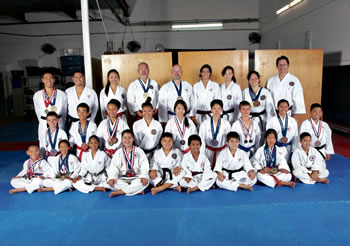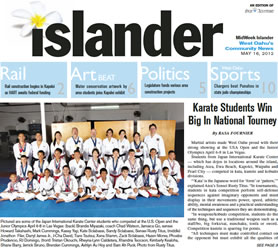Karate Students Win Big In National Tourney

Pictured are some of the Japan International Karate Center students who competed at the U.S. Open and the Junior Olympics April 6-8 in Las Vegas: (back) Brandis Miyazaki, coach Chad Watson, Jamaica Go, sensei Howard Takahashi, Mark Cummings, Kasey Yap, Kate Sclabassi, Sandy Sclabassi, Sensei Rusty Titus, (middle) Jonathon Filer, Darryl James Jr., J-Cha David, Tiare Tsutsui, Xena Stamm, Zack Sclabassi, Hazen Morse, Phoebe Prudencio, RJ Domingo, (front) Tristan Okouchi, Rheyna-Lynn Caldetera, Xhandria Teocson, Kimberly Kealoha, Shane Barry, Jerrick Siruno, Brenden Cummings, Ashlyn Au Hoy and Sam Ah Puck. Photo from Rusty Titus.
Martial artists made West Oahu proud with their strong showing at the USA Open and the Junior Olympics April 6-8 in Las Vegas.
Students from Japan International Karate Center – which has dojos in locations around the island, including Aiea, Ewa Beach, Kapolei, Waipahu and Pearl City – competed in kata, kumite and kobudo divisions.
“‘Kata’ is the Japanese word for ‘form’ or ‘pattern,'” explained Aiea’s Sensei Rusty Titus. “In tournaments, students in kata competition perform self-defense sequences against imaginary opponents and must display in their movements power, speed, athletic ability, mental awareness and a practical understanding of the techniques and sequences they are demonstrating.
“In weapons/kobudo competition, students do the same thing, but use a traditional weapon such as a staff/bo, big forks/sai, nunchaku, tonfa or sword. Competition kumite is sparring for points.
“All techniques must make controlled contact on the opponent but must exhibit all the qualities of true martial arts punches, strikes and kicks.”
Titus noted that preparing for competition means hours of additional dedication each week: “At the Japan International Karate Center, regular students attend classes twice weekly. Competition class students must attend three additional trainings – five additional hours per week. Weapons classes and some black belts also attend extra sessions.”
Students begin competing once they are at the orange belt level, which generally means they have been training at least 6-9 months. JIKC’s competitors range in age from 6 to adults, with 32 of the school’s 65 competition class students attending the April 7-8 U.S. Open, and students 17 and under attending the April 6 U.S. Junior Olympics. All told, JIKC competitors walked away with 32 medals, three wins by Kapolei dojo’s J-Cha David, and three by Pearl City dojo’s Rheyna-Lynn Caldetera. Brandis Miyazaki, also from the Pearl City dojo, won a silver medal in kumite in the North American Cup, an all-adult competition April 5 between the United States, Canada and Mexico.






